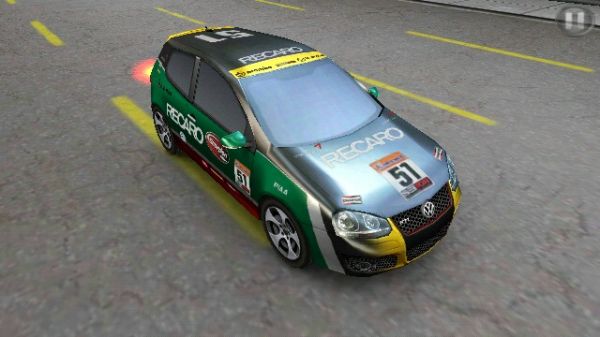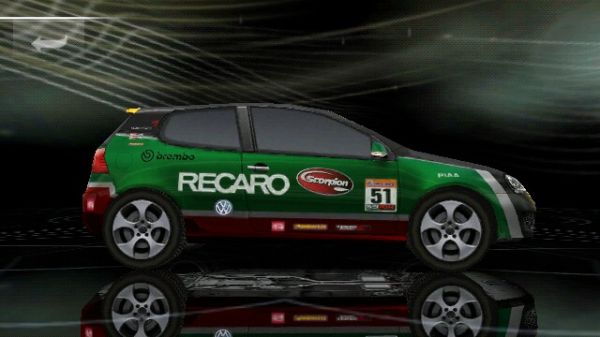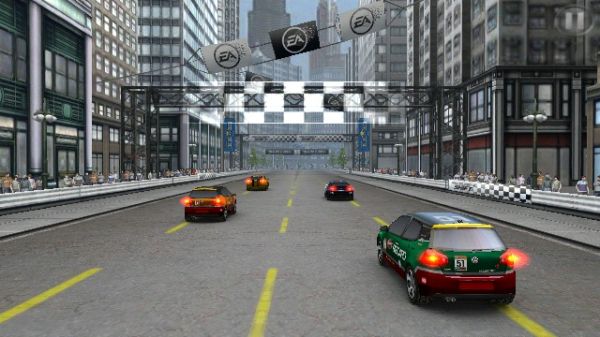Nokia N8 Review: Nokia's New Flagship
by Mithun Chandrasekhar on January 12, 2011 1:00 AM EST- Posted in
- Smartphones
- Nokia
- N8
- Symbian
- Mobile
Look who’s calling the shots…
The N8 represents many firsts for Nokia. It is the first phone to be based on the Symbian^3 platform. It is the first Nokia phone to carry a 12MP camera sensor. It is also the first Nokia phone to have a discrete GPU. And finally, it is the first mainstream Nokia phone to be multi-touch capable (and just the 2nd to have a capacitive screen) and have a GPU accelerated UI, both of which are as a result of switching to Symbian^3. And when it comes to the display and what’s driving it, the Nokia N8 doesn’t disappoint.


NFS Shift HD running on the BMC2727 in the Nokia N8
While I’ll get to the biggest change in the N8 that is the Symbian^3 OS in a while, Nokia has also updated what’s calling the shots behind the scenes. Up until Symbian^3 came along, Nokia rarely ever bothered with including a GPU in its phones and even when it did, it was never really put to any good use. Its last N-Series flagship, the N97, didn’t even have a GPU per se. Except for the Cortex A8-touting outlier that the N900 is, the best that Nokia has done in terms of integrating GPU’s into phones is make use of the OMAP 2420 SoC, which included a PowerVR MBX GPU, in a handful of its previous devices and even this was left mostly unutilized. Things have changed, for the better, with the Nokia N8. Although Nokia is still sticking with a tried and tested ARM 11 implementation for its CPU, it has actually gone ahead and made full use of a discrete Broadcom BCM2727 Multimedia processor for graphic duties. While you can see performance numbers later in the review, the general impression is that it is fairly competent as a GPU.
Nokia’s choice of using an aged ARM 11 implementation, down-clocked to 680 Mhz (instead of the spec’d 772 Mhz) for its CPU may draw criticism in this day and age of gigahertz-capable, multi-core mobile SoC’s. But digging a little deeper seems to show that there may be some method to this madness. You see, pretty much everything in the N8 runs around the BCM2727 media processor. I would hazard a calculated guess that apart from lightweight low-level OS functions and interfacing with the baseband and other radio’s, there isn’t much else for the CPU to do on the N8. Plus, Symbian’s inherently efficient use of available resources helps too.
So what was needed in this case was a low-power, package efficient CPU design that could just about get the job done while sipping as little power and occupying as little space as possible. And this is almost exactly what Nokia found in the Samsung K5WXXXXXXX series of Fusion Memory MCP’s. This MCP (Multi Chip Package) allows Samsung to stack different memory types (DDR, NAND etc.) along with non-memory logic in the same low-power package. So for basically the same footprint as a single memory chip, Samsung is able to integrate the DDR memory (256MB), NAND (512MB) and a CPU (TI ARM11 applications processor).
Most of the heavy lifting in the N8 is done by the BCM2727, as it renders the Symbian^3 UI and games alike, works with the camera module to capture and process 12MP stills and 720p videos, encodes/decodes those videos, drives the HDMI output (upto 720p) and even decodes the audio. So in case of the N8 and Symbian^3, it made sense for Nokia to have a low-power ARM11 CPU coupled with a reasonably powerful and competent multimedia processor. Using an A8 Cortex-based 1Ghz+ part here to run Symbian^3 would have been overkill and power-inefficient. And this decision is quite obvious when you use the N8. The UI is very fluid and responsive with crisp transitions and swift app switching. Furthermore, the N8 posted very competitive battery life numbers to further substantiate Nokia’s decision here.












119 Comments
View All Comments
cheezyuser - Wednesday, January 12, 2011 - link
I'm not trying to sound fanboism, but thats my point exactly, People are just harping on Android, iPhone, apps, and when it comes to Nokia, they are quick to point out the flaws, which in my point, there isnt much (except for thoes synthetic benchmarks). Anandtech is mostly right in what they say, and it gets the job done,Just because my phone has the highest battery life doesnt mean im not gonna charge it for long days, nor does it display web pages faster mean i can tweet faster then my friends.
this android/iPhong hype is going over the top
inaphasia - Wednesday, January 12, 2011 - link
"...the 5110i served me very well for more than 3 years without showing any signs of aging. That was in the mid to late 90’s"Not that it matters but that phone probably came out around 98-99. I remember 'cause '99 was the year I got my first mobile. A Motorola that would take 4xAA alkalines if you wanted! I loved the 5110 but by the time my Motorola died I ended up with my favorite phone ever, a Nokia 6210. Had it for a little over 4yrs! No really!
jonup - Thursday, January 13, 2011 - link
Second on the 5110, which I had. And while not much different I was always a big fan of 6310i but the 6210 would do as one of the greatest ever. But for the pure market share 5110 was the king. Just about every one had one.santu - Thursday, January 13, 2011 - link
I was hoping that Anadtech review talks about signal loss problem when touching the phone. I have gone through three phones and all have antenna problem. Even in the user manual, Nokia recommends the user not to touch the phone in certain places.Luke.mc - Thursday, January 13, 2011 - link
Mithun, one of the gripes with the phone seemed to be the poor browser, but you also said Opera Mobile was an excellent experience. Could you post your tests using Opera Mobile on multiple phones as to give a more accurate hardware picture?mythun.chandra - Friday, January 14, 2011 - link
I'd like to do so. But as of now, I do not have enough devices on hand to put reference numbers. Plus, even out of the few devices I do have, only the Nokia's have Opera Mobile available. But I will make it a point to include reference Opera Mobile wherever possible :).mcquade181@gmail.com - Friday, January 14, 2011 - link
I've had my N8 for 6 weeks now. It replaced a 2 year old Nokia N95. I'm reasonably happy with it although for phone calls my N95 was better.I had previously borrowed a couple of Android phones (both v2.1) to try out and found then bug ridden heaps of 2nd rate hardware (both were HTC's).
I've found the N8 to be quite a bit better than them, however all is not roses with the N8 as I have issues with the N8's front and rear speaker/ringer design and volume.
If you put the N8 on a soft flat surface or carry it in a leather belt pouch the ringer is completely inaudible! The engineers who designed the rear speaker must been straight out of Uni without any design experience! The speakers should have been twin side mounted speakers aka N95.
Another issue that I have is with lack of earphone speaker volume - in a noisy environment the phone is useless - hopefully this will be addresses in a firmware update.
I'm not the only one complaining about these two issues - do a google search for "N8 volume".
noxplague - Saturday, January 15, 2011 - link
I have had the N8 for three weeks now and, while everyone on here who has never used one is all worried about the specs and the tests these, volume issues are far more relevant in day to day use.One thing that frustrates me to no end is the fact that on the home screen using the volume rocker does nothing! To me this should be the quick way to change my ringer volume. Instead you are supposed to use these "profiles", but having a profile with the right volume for each scenario is time consuming when I just want to turn the volume up or down but leave the rest of the settings (there are loads) alone.
The phones that I switch between lately are a WP7 Samsung Focus, a Palm Pre Plus (need to pick up the 2...), and the Nokia N8. The email/exchange experience on the N8 is my main problem. It lags so far behind the competition to be considered barely usable. The fact that you cannot easily contact meeting attendees from the calendar is a huge oversight compared to the WebOS, WP7 OSs. When you move between meetings all day and are running late it is nice to be able to let people know quickly.
My last comment is on Opera Mobile 10.1 - Everyone talks about how great it is but for me it crashes a far amount and doesn't support pinch zoom! This is annoying whenever you are on a full website. I often switch between Opera and Web, but even slow I find Web better just because it doesn't crash and I can zoom around a website.
Fix the exchange experience, the volume experience, and the web and this phone would be a top contender.
The hardware is stunning, preferable to either the palm, focus and camera is worth it alone.
munky - Friday, January 14, 2011 - link
All you people whining about ARM11, MHz, and so-called "standards" have obviously never used the N8. Kinda reminds me of all the armchair photographers who argue about camera specs without ever using it. As a photo enthusiast, the camera alone makes this phone worth considering, and instantly makes all the other phone cameras look like stone age tech.It has 3G on all 5 bands, meaning I can get T-Mobile 3G for $6/month, no contract, as opposed to all your mandatory 2-year contracts with $30/month data plans elsewhere.
The AMOLED screen has great colors and visibility in any lighting condition, something Apple still hasn't "invented."
The multi-tasking capabilities are second to none - try following turn-by-turn navigation while listening to music while taking pictures all at the same time on your phone, and tell me how it goes.
The reception on this phone is even better than previous Nokia's I've owned. The company with a fruit logo is not even playing in the same ballpark.
The web browsing is smooth also, and I can view flash content directly in the browser - I don't need no stinking "app for that."
Now, if all you do is browse the web and download games for your phone, then you don't need the N8. Hell, you don't need a phone at all - get an Ipod Touch and go brag to your neighbors. But if you want a multimedia device with some real capabilities, then don't bash the N8 until you've actually used it.
pandemonium - Saturday, January 15, 2011 - link
Well said, munky.For everyone else needing another perspective on the N8's abilities, you need to read these two articles on gsmarena.com: http://www.gsmarena.com/nokia_n8-review-523.php; http://www.gsmarena.com/display_shootout-review-54...
That site has several well thought out and fair comparisons and reviews of several brands and models.
My personal experiences with Nokia devices in general have taught me that battery life is amazing, hardware quality is the best, Symbian OS is sometimes twitchy but very efficient and adaptable, call and reception quality are better than most, and value is very high compared to cost [against other brands]. You can compare listed specs all day long, but when it comes down to it the function of the OS against the capabilities of the hardware and the utilization and limits of software combined is what makes a great phone great. It's the same as HDTVs; so what if yours has 5,000,000 : 1 contrast ratio? Those numbers are inflated and only relevant within that brand and that brand alone and say nothing about color accuracy, black levels, viewing angle, subfield motion correction, etcetera, etcetera.